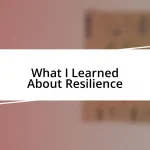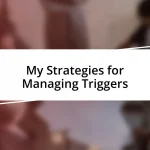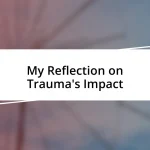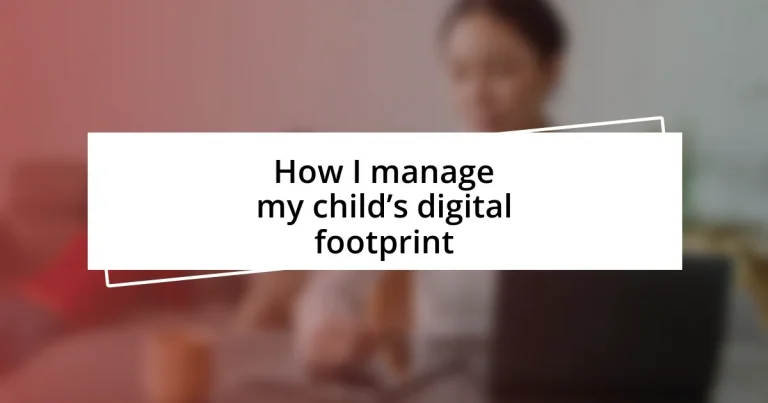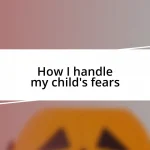Key takeaways:
- Digital footprints consist of both intentional posts and background data, emphasizing the need for open discussions about online presence with children.
- Managing a child’s digital footprint is essential for their reputation, privacy, and future opportunities, fostering a sense of responsibility and empowerment.
- Setting privacy settings together promotes understanding and dialogue, helping children learn about their online identity and control over shared information.
- Encouraging open communication and regularly reviewing digital habits helps children navigate online interactions mindfully and develop critical thinking skills.
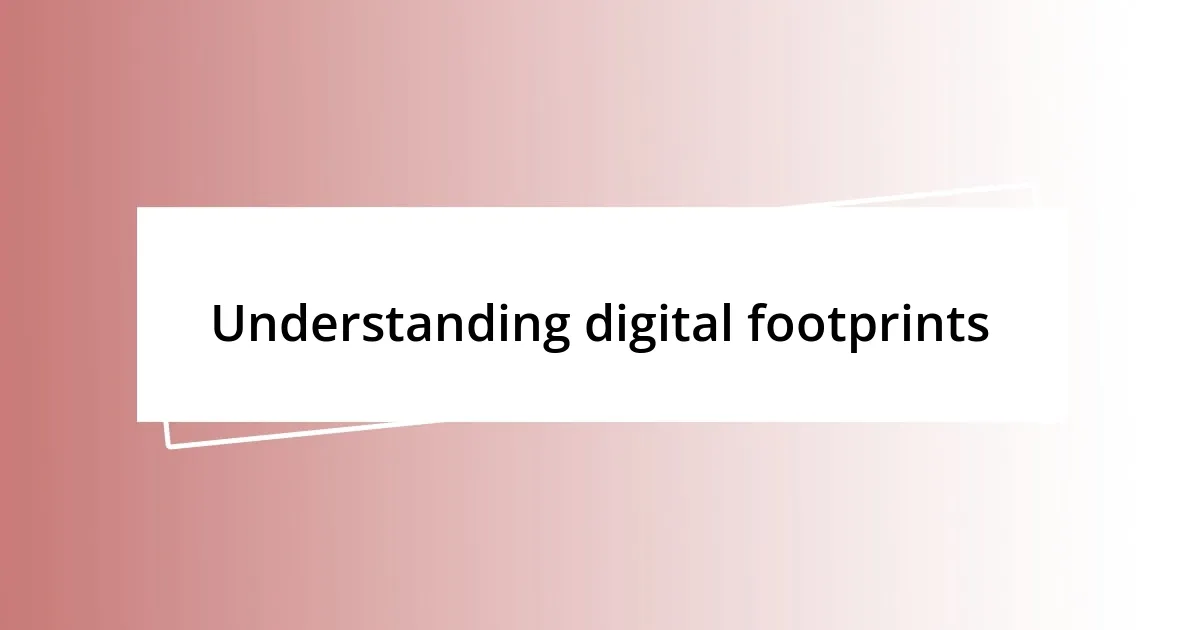
Understanding digital footprints
When I first learned about digital footprints, I was surprised, and honestly a bit overwhelmed, by how much information my child was unknowingly creating online. It’s astonishing to think that every post, comment, and like contributes to a trail that can be followed long after it’s made. Do we really understand the extent of that impact?
A few months ago, I stumbled upon an old photo of my child on a friend’s social media page. It caught me off guard because I hadn’t been aware that it was shared publicly. It reminded me how easily our kids’ lives can become intertwined with their digital identities, often without their full understanding. It made me wonder; are we doing enough to educate them on managing this invisible legacy?
As I have navigated this journey, I’ve come to realize digital footprints are not just about what’s posted intentionally, but also about the data collected behind the scenes, like app usage and browsing history. This realization weighed heavily on me—how many times do we scroll past terms and conditions without a second thought? By discussing these aspects openly with my child, I hope to instill a sense of responsibility and mindfulness that will guide them as they grow.
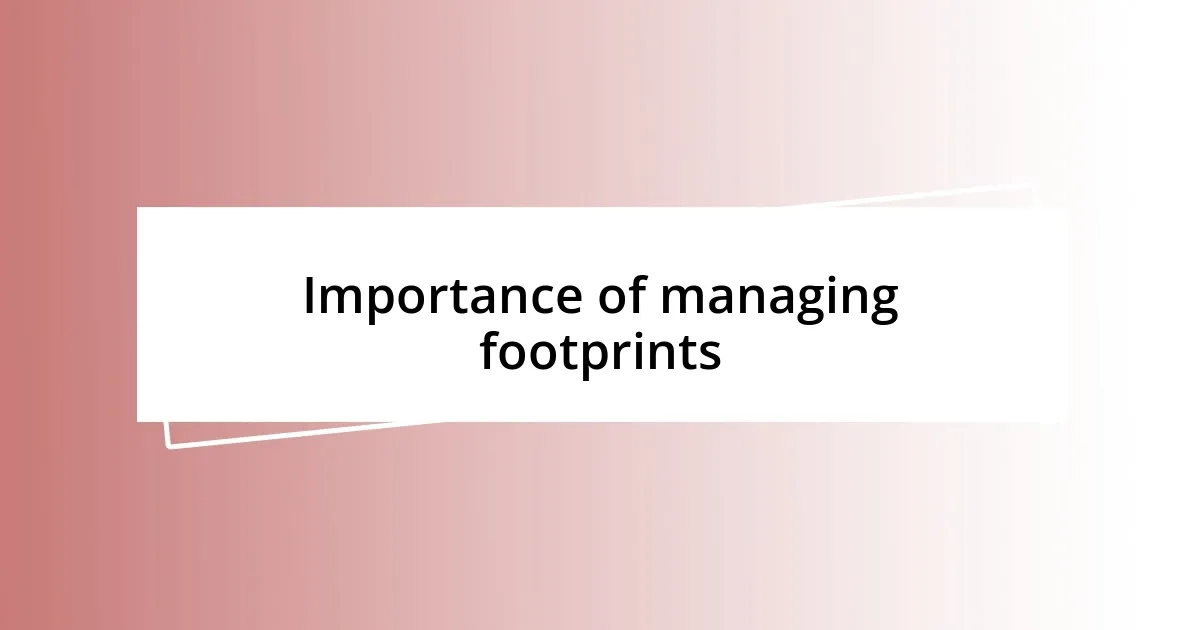
Importance of managing footprints
Managing a child’s digital footprint is incredibly important because it shapes their online identity and future opportunities. Recently, I came across a blog post detailing how employers often search applicants’ social media profiles. It struck me that something innocent, like a playful photo or a silly comment made in the past, could potentially hinder my child’s prospects down the line. I want my child to be confident in everything they share, knowing it reflects the person they are or aspire to be.
Here are a few reasons why managing digital footprints is crucial:
– Reputation: What’s posted online can last forever, influencing how others perceive your child.
– Privacy: Understanding what information is shared helps control personal data and safeguard against potential risks.
– Opportunities: A polished digital presence can open doors—for education, employment, and social connections.
– Awareness: Teaching children about their digital footprint fosters a sense of responsibility in their online interactions.
– Empowerment: When children actively manage their footprints, they feel more in control of their digital lives.
Each of these points resonates deeply with me, as I strive to help my child navigate the complexities of the internet in a mindful way.
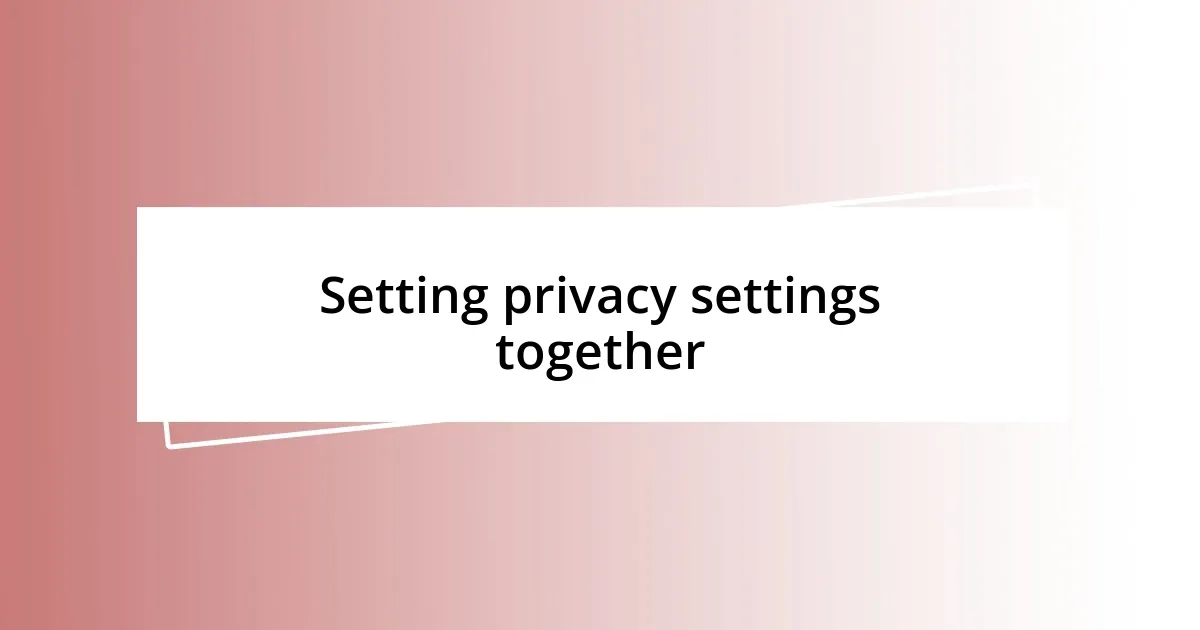
Setting privacy settings together
Setting privacy settings together has been a game changer in our household. I recall the first time my child and I sat down to dive into these settings on their social media profiles. It felt empowering not just for them but for me as well. Together, we navigated through the language of privacy options, discussing what each term meant. “Public” vs. “private” can be a bit convoluted for kids, so I made it a point to emphasize how setting these parameters is like closing the curtains in our home. It gives us control over what others can see.
I’ve found that these moments are about more than just adjusting settings; they’re about opening a dialogue. One afternoon, we tackled the privacy settings for a popular gaming platform. I could see my child’s eyes light up when they realized they could choose who could see their profile and interact with them. That realization sparked a conversation about trust, connection, and the importance of sharing only with those who truly matter. It felt almost like a rite of passage. It made me feel proud to be part of their journey toward digital literacy.
Engaging in this process together not only helps in understanding the tools available but also strengthens our bond. As we occasionally revisit these settings, I observe my child becoming more discerning about the information they want to share. It’s gratifying to see them take ownership of their online presence. Each time we revisit these settings, it becomes a reminder of the ongoing nature of this education. After all, as technology evolves, so do the challenges and responsibilities that come with it.
| Privacy Feature | What It Means |
|---|---|
| Public Profile | Anyone can see the content you share. |
| Private Profile | Only approved friends or followers can view your posts. |
| Location Sharing | Allows others to see your physical location. |
| Activity Status | Lets others know when you are online or last active. |
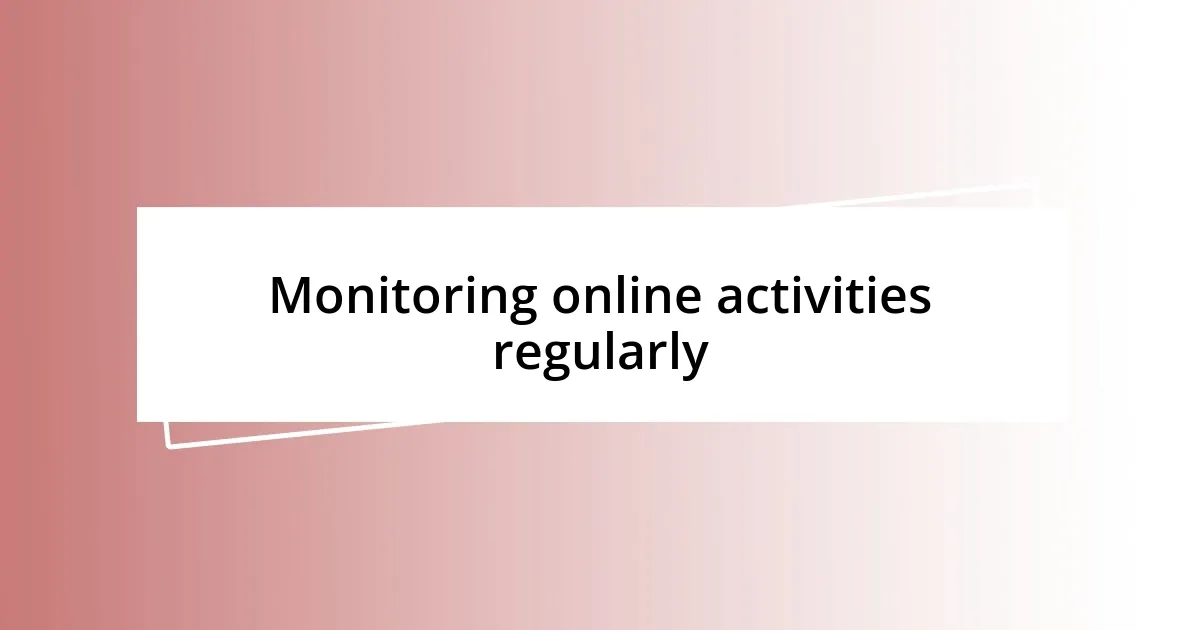
Monitoring online activities regularly
Monitoring my child’s online activities regularly has become a cornerstone of our approach to digital parenting. I’ve set aside time each week, often on Sundays, to sit down with my child and review their online interactions. This isn’t about snooping; it’s more like a collaborative exploration. Together, we check out their social media posts and messages, ensuring everything aligns with the values we cherish. I can’t help but wonder—are we truly aware of the digital communities our children are engaging with?
It’s fascinating to see how my child’s attitude toward their online presence evolves during these sessions. I remember one time, we stumbled upon an old post that sparked a thoughtful discussion about how friendships change over time. It was a light-hearted moment, but it also highlighted the importance of curating their online identity. Observing my child express pride in a well-crafted post makes me feel accomplished as a parent. After all, are we not aiming to equip them with the skills to navigate their digital world responsibly?
While monitoring their activities, I also emphasize the concept of empathy. I frequently ask my child how they’d feel if someone posted something similar about them. This simple question fosters compassion and helps them consider the wider impact of their words and actions online. Seeing them actively engage in this reflection warms my heart. It’s reassuring to know that, with each session, they’re learning to be mindful of their digital footprint, paving the way for a more thoughtful online presence as they grow.
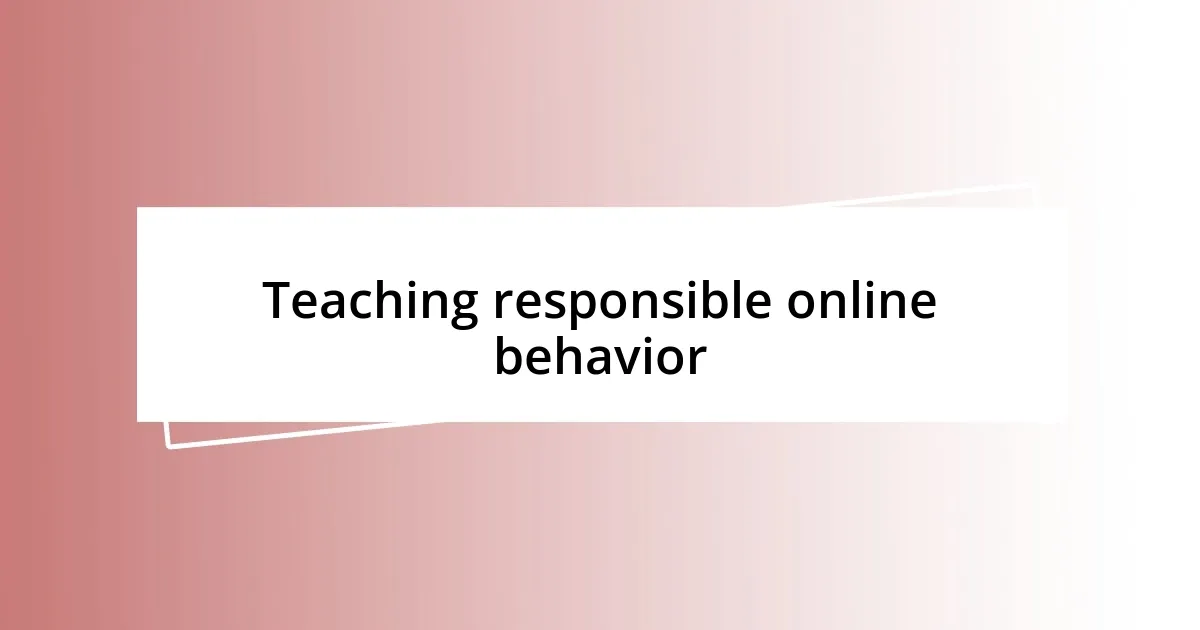
Teaching responsible online behavior
Teaching responsible online behavior is a journey I take seriously, and I’ve found that leading by example is one of the most effective strategies. I often share my own experiences with social media mishaps, sometimes even showing my child a photo I regretted posting. It’s made my child realize that every choice online has potential consequences, just like in real life. For instance, I once deleted a post after realizing it didn’t represent my values. That moment became a learning point for us—a conversation starter about being intentional in our online expressions.
Another approach I’ve embraced is encouraging open discussions about the content they consume online. One evening, as we were winding down for the night, I casually asked about their favorite YouTube channels. What started as a simple question turned into an enlightening discussion about misinformation and how not everything on the internet is reliable. My child’s eyes widened at the thought! I felt joy knowing we were fostering critical thinking together. It’s a reminder that, in the digital age, discernment is just as vital as creativity.
I also emphasize the importance of digital etiquette by engaging my child in role-playing scenarios. For example, I’ll ask them how they would respond to negative comments on a post. One time, during our playful back-and-forth, they confidently articulated a respectful response that turned the hypothetical situation into a constructive conversation. Isn’t it incredible to witness your child gain interpersonal skills that will last a lifetime? Each of these interactions molds their character, and I get to be a part of that beautiful evolution as they train their minds for responsible online citizenship.

Encouraging open communication
Encouraging open communication around digital footprints has been a game-changer in my parenting approach. I vividly remember a moment when my child came to me, upset by a comment they received on a social media post. Instead of brushing it off, we sat together and unpacked their feelings. It felt so rewarding to create a safe space where they could express their frustrations. I sometimes wonder—how often do we offer our children that space to really speak their minds?
I strive to keep our communication channels wide open, especially when it comes to sensitive topics like online interactions. One strategy that has worked well for us is scheduled “tech talks,” where we casually discuss their online experiences over hot chocolate. During one of these chats, my child shared how a friend was being bullied online. It sparked an essential conversation about allyship and how to support peers in tough situations. Seeing them take this issue seriously made me feel proud and hopeful about their empathy.
I often reinforce the idea that no topic is off-limits. I remember asking my child what they thought about online challenges that go viral. At first, they hesitated, but I assured them that their perspective mattered. As they slowly opened up, I could see a lightbulb moment—understanding the difference between fun, safe challenges and those that could lead to trouble. This ongoing dialogue not only strengthens our bond but also empowers them to navigate their digital world with confidence. Isn’t that what we all want for our kids?
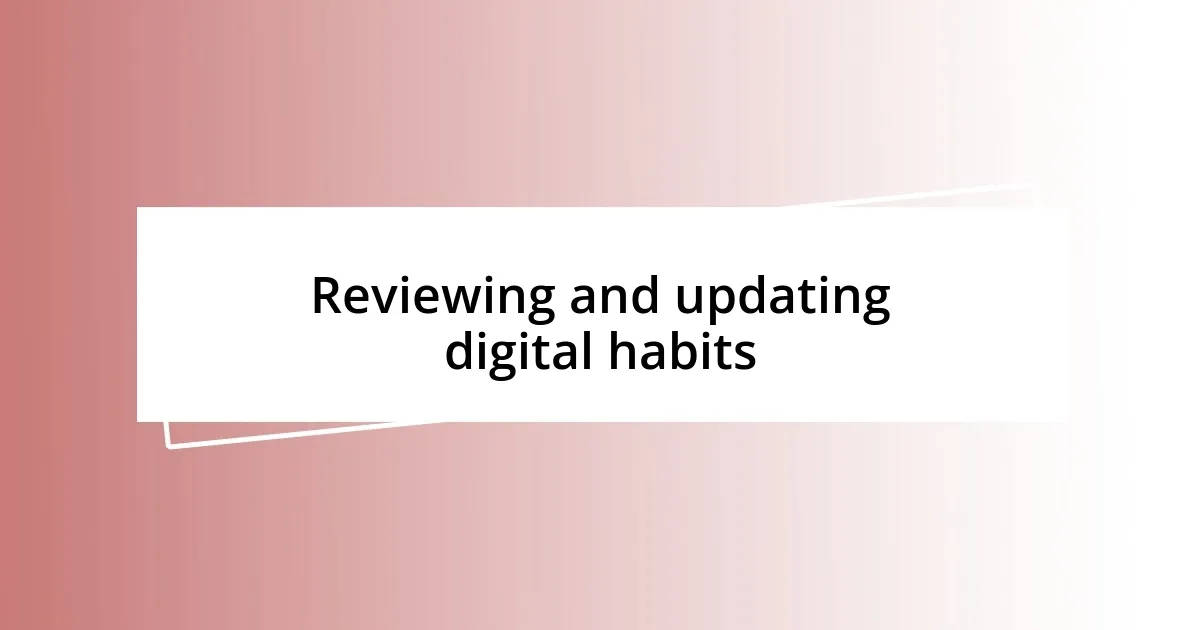
Reviewing and updating digital habits
Regularly checking in on my child’s digital habits has become a cornerstone of our routine. I remember just last week when we sat down to review their social media privacy settings together. The moment was surprisingly eye-opening; as we clicked through the options, my child realized how much control they actually had. It was empowering to see them take ownership of their online presence, thinking, “Wow, I didn’t know I could limit who sees my posts!” Such moments show that reviewing digital habits isn’t just an obligation—it’s a chance for growth.
Updating digital habits isn’t a one-time discussion; it’s an evolving practice. I often find myself asking my child about new apps they want to try. Just the other day, they were excited about a particular game, but before jumping in, we explored it together. As we skimmed through user reviews and potential risks, I could tell they appreciated being part of the decision-making process. It reminded me of how we often overlook the importance of a guided approach in shaping their choices. It’s impressive to witness them applying critical thinking skills we’ve developed through conversations.
Furthermore, I make it a point to reflect on our discussions from time to time. For example, I’ll ask them how they’ve felt about their online interactions over the past week. Recently, we spoke about the rise of influencers and the pressure to fit in. Their honesty in sharing concerns about unrealistic portrayals was a testament to how our previous talks had impacted them. I couldn’t help but feel proud of their self-awareness. It’s these candid reflections that continuously inspire me to adapt our strategies, ensuring their digital footprint remains thoughtful and true to who they are. Isn’t that the ultimate goal we all strive for?
